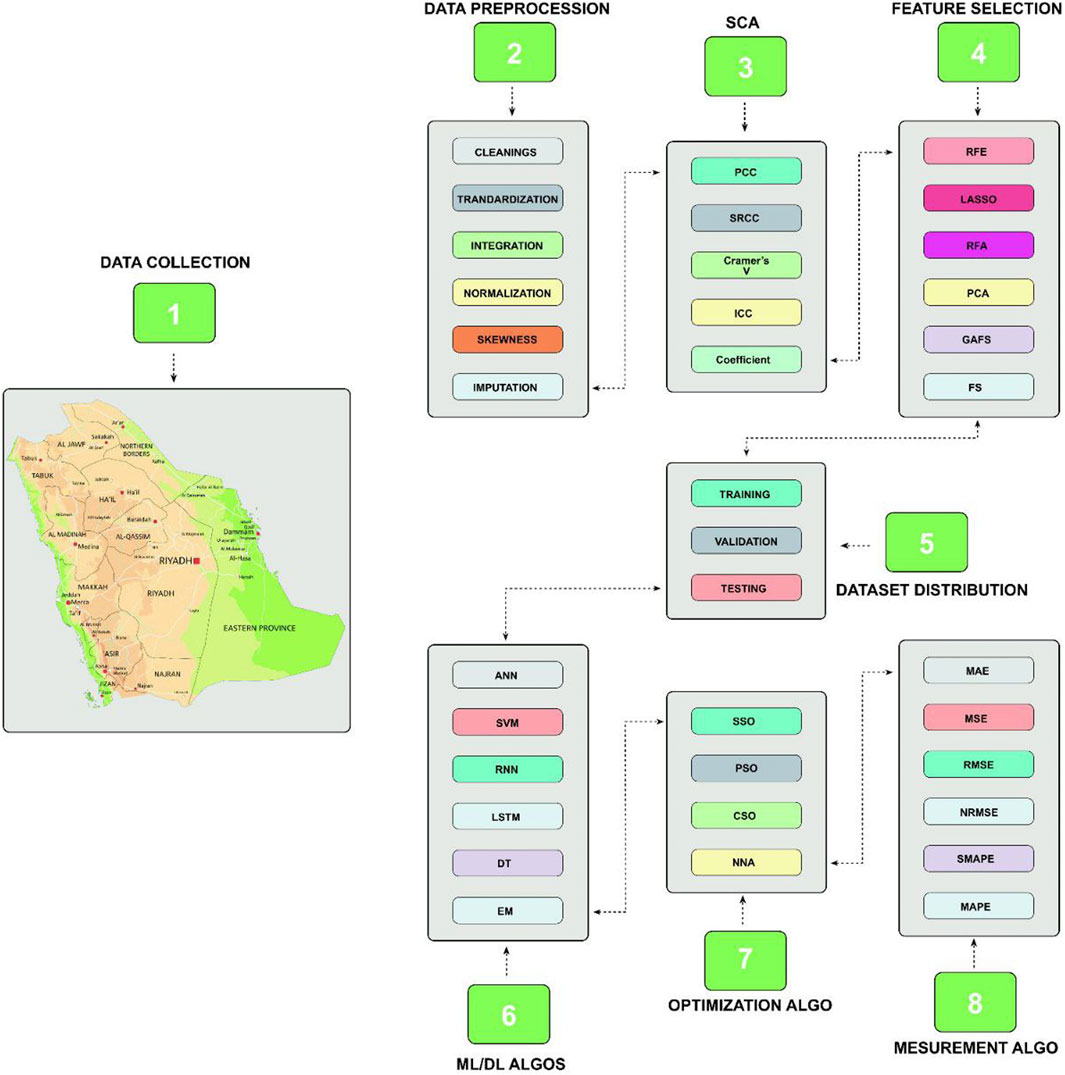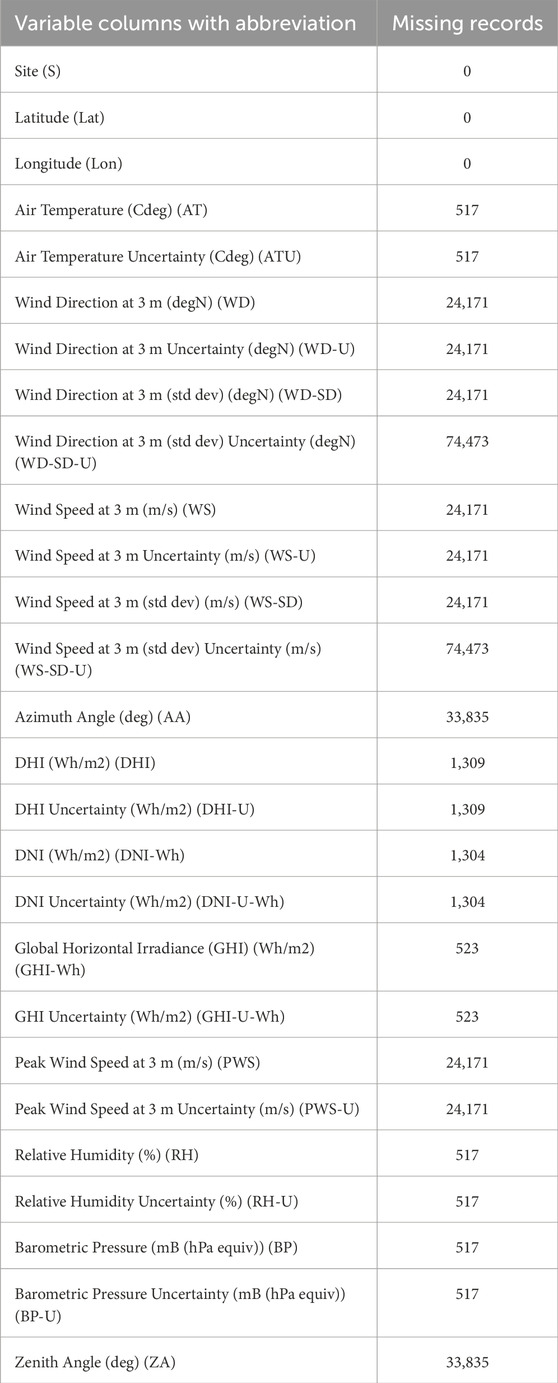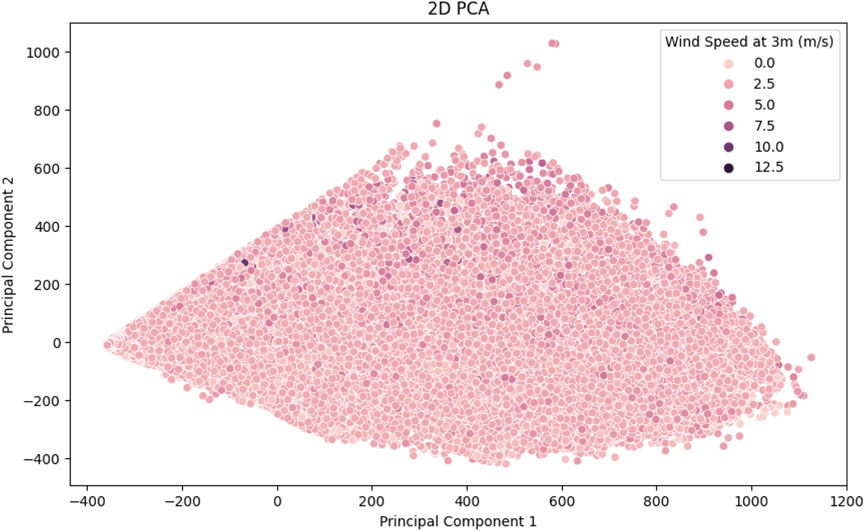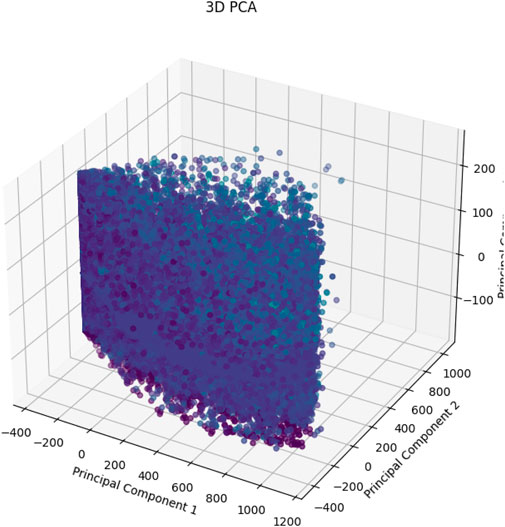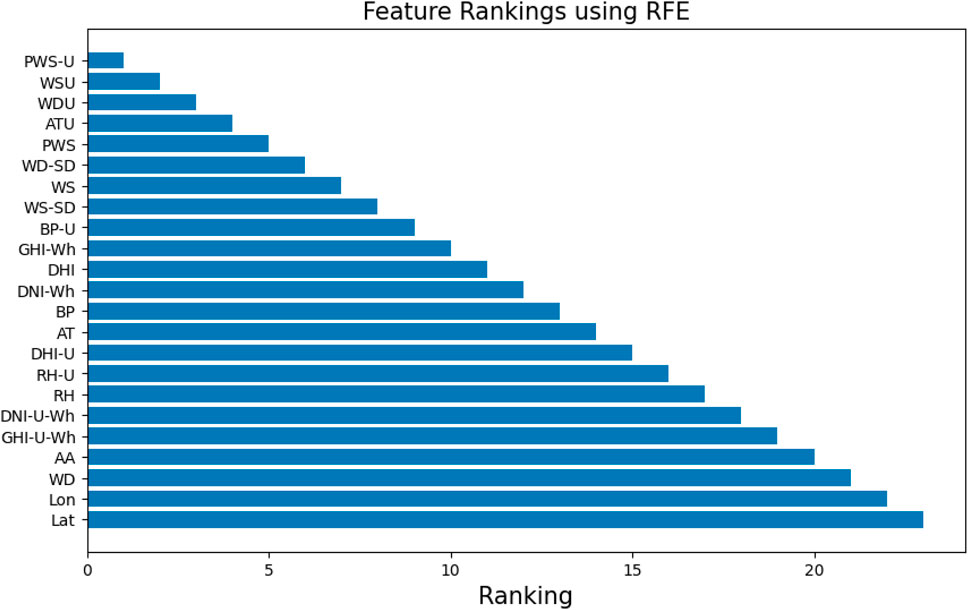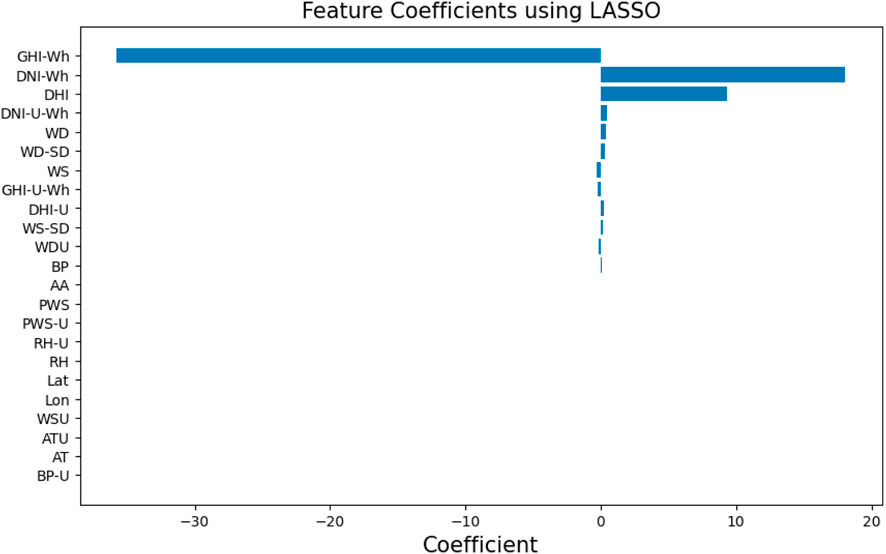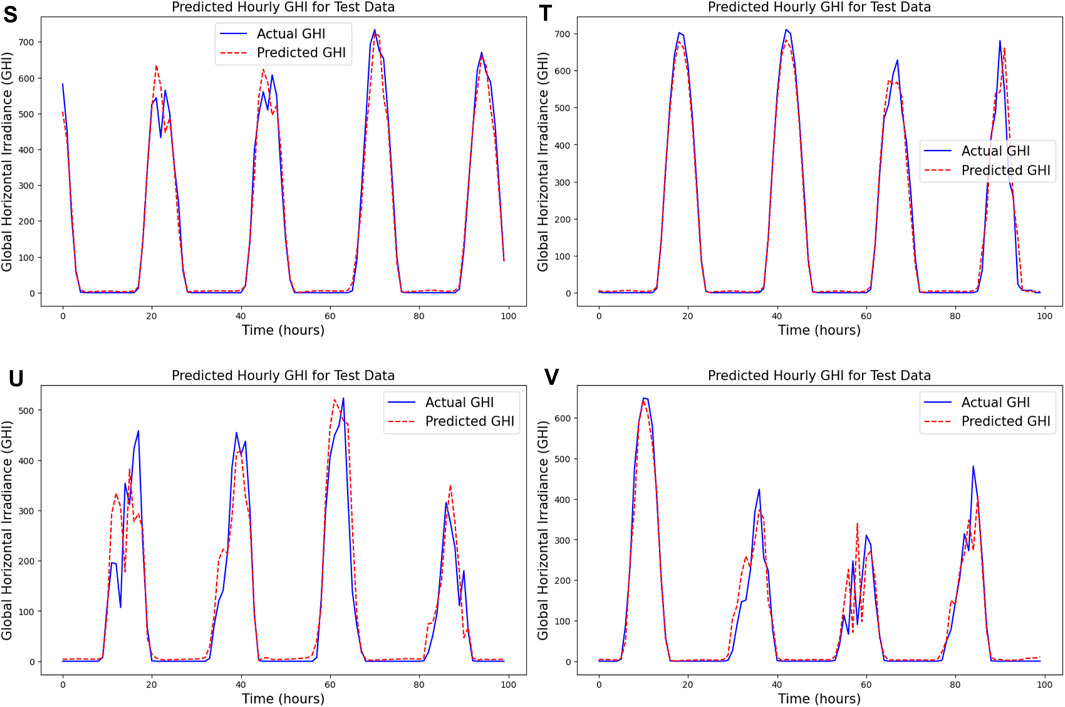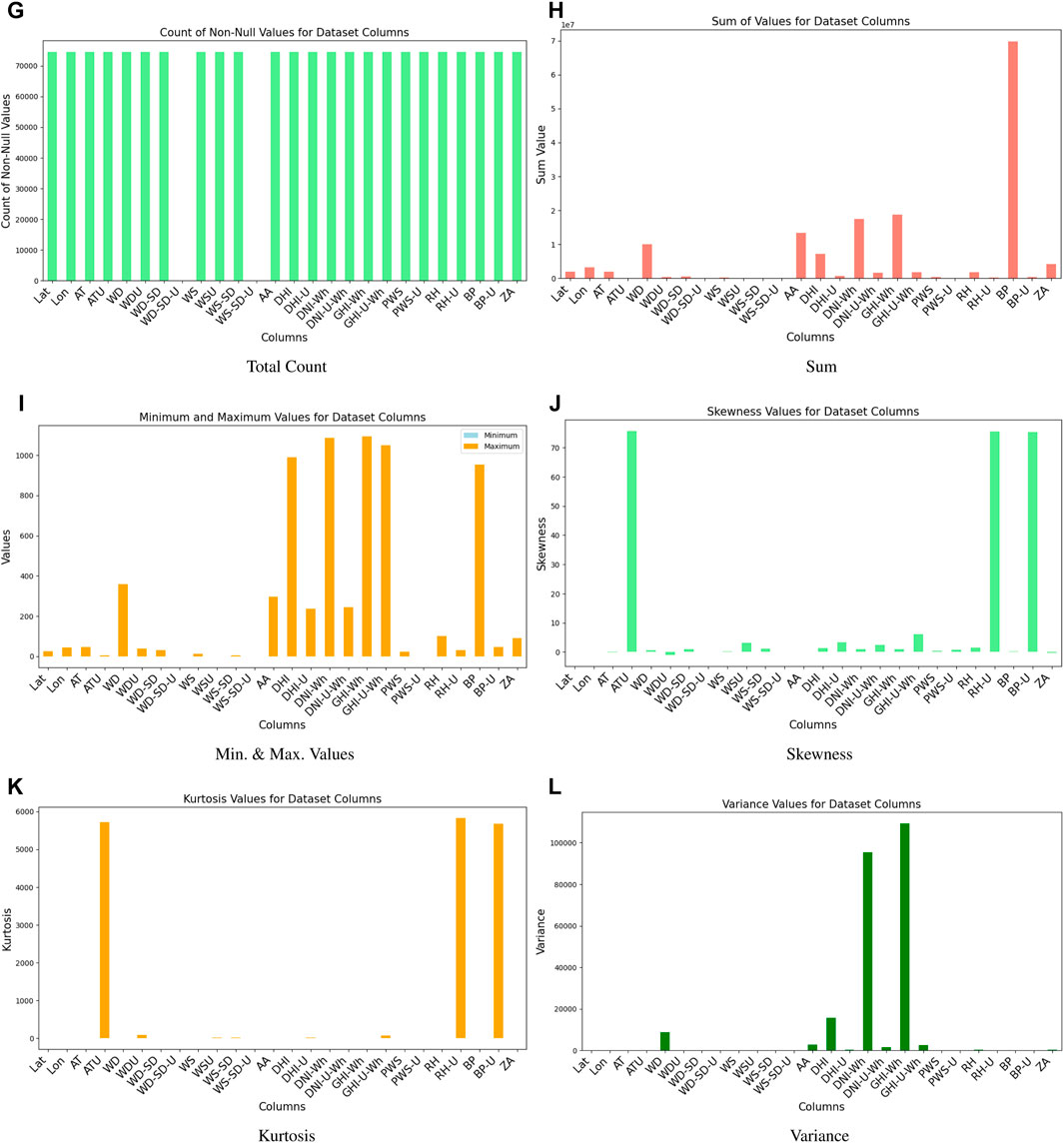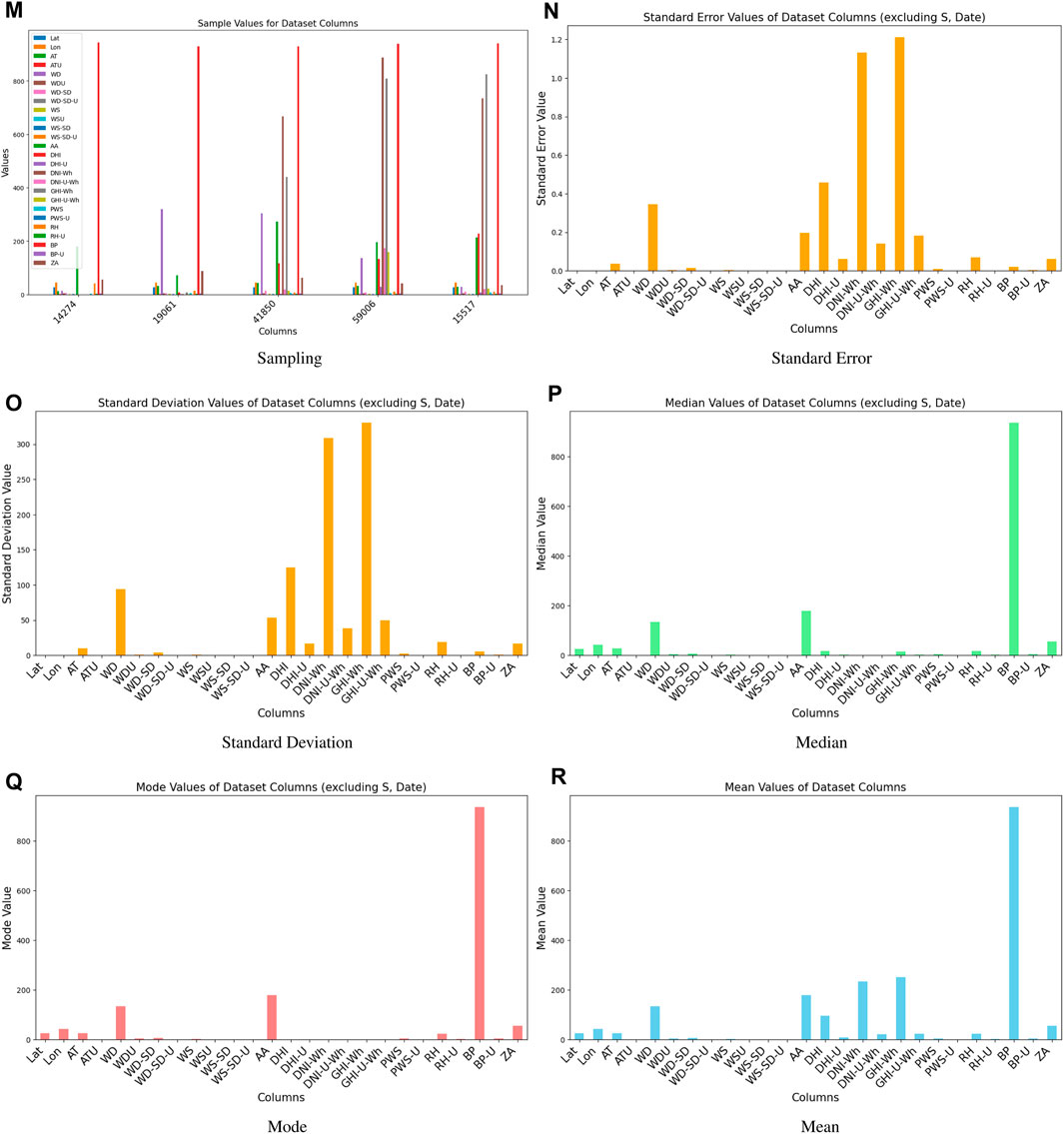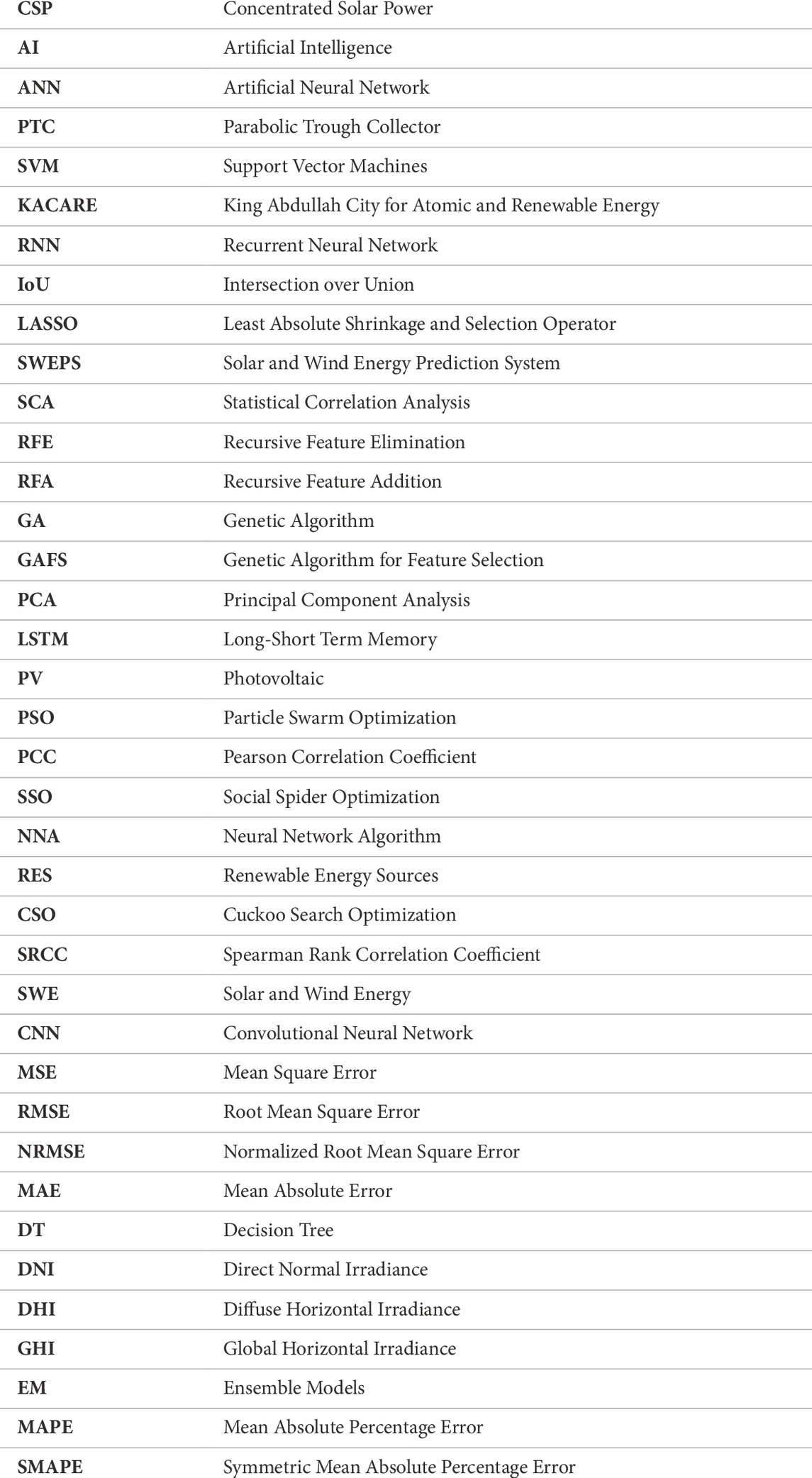- 1Department of Electrical Engineering, College of Engineering, Qassim University, Buraydah, Saudi Arabia
- 2Department of Computer Science, Faculty of Information Technology and Computer Science, University of Central Punjab, Lahore, Pakistan
Global power grid management depends on accurate solar energy estimation, yet present prediction techniques frequently suffer from unreliability as a result of abnormalities in solar energy data. Solar radiation projections are affected by variables such as anticipated horizon length, meteorological classification, and power measuring techniques. Therefore, a Solar Wind Energy Prediction System (SWEPS) is proposed as a solution to these problems. It improves renewable energy projections by taking sun trajectories and atmospheric characteristics into account. In addition to using a variety of optimization methods and pre-processing techniques, such as Principal Component Analysis (PCA), Recursive Feature Elimination (RFE), Least Absolute Shrinkage Selection Operator (LASSO), and recursive feature addition processes (RFA), complemented by a genetic algorithm for feature selection (GAFS). The SWEPS also makes use of sophisticated machine learning algorithms and Statistical Correlation Analysis (SCA) to find important connections. Neural Network Algorithms (NNA) and other metaheuristic techniques like Cuckoo Search Optimization (CSO), Social Spider Optimization (SSO), and Particle Swarm Optimization (PSO) are adopted in this work to increase the predictability and accuracy of models. Utilizing the strengths of machine learning and deep learning techniques (Artificial Neural Networks (ANN), Decision Trees, Support Vector Machine (SVM), Recurrent Neural Networks (RNN), and Long Short Term Memory (LSTM)) for robust forecasting, as well as meta-heuristic optimization techniques to fine-tune hyper-parameters and achieve near-optimal values and significantly improve model performance, are some of this work contributions to the development of a comprehensive prediction system.
1 Introduction
A major oil-producing country extracts about 10 million barrels of oil per day, Saudi Arabia is presently involved in deliberate efforts to dramatically increase the share of renewable energy in its overall energy mix. By 2030, the country aims to deploy 58.7 gigawatts (GW) of renewable energy capacity, demonstrating its ambitious commitment to sustainable energy sources. The government’s all-encompassing strategy to meet this lofty goal mainly depends on utilizing the nation’s plentiful solar resources and taking advantage of the quick cost reductions seen in the solar industry. The primary objectives include achieving energy self-sufficiency, bolstering energy security, fostering stable and long-term economic advancement, all while mitigating carbon dioxide emissions through efficient utilization of the region’s considerable solar potential Al Garni et al. (2016).
Furthermore, as part of its efforts to transition towards a sustainable energy future, Saudi Arabia is also implementing smart city initiatives. These smart cities leverage advanced technologies, data analytics, and interconnected systems to optimize energy consumption, enhance resource efficiency, and improve overall quality of life. By integrating renewable energy generation, energy-efficient buildings, smart grid infrastructure, and intelligent transportation systems, these smart cities play a vital role in achieving the country’s renewable energy targets while creating sustainable and livable urban environments. Saudi Arabia is actively implementing various smart city initiatives to transform urban areas into sustainable and technologically advanced environments. Here are some examples of smart city initiatives in Saudi Arabia: NEOM, King Abdullah Economic City (KAEC), Riyadh Smart City, Jeddah Economic City, and Smart Metering.
Major solar energy technologies in the country include
Because conventional energy sources are unsustainable and detrimental to the environment, there has been a recent upsurge in the study of alternative energy sources. Furthermore, the growing global energy crisis presents a formidable obstacle, given that technical and economic advancements strongly depend on the accessibility of energy, which is necessary for global industrialization and urbanization. On the other hand, the continued increase in the world’s population exacerbates the severity of energy shortages everywhere. An increase of up to 70% is predicted in the power demand. Fossil fuels were declarable as the leading sources of electrical energy production throughout the 20th century, and they still play this role today Duffy et al. (2015). However, extended usage of fossil fuel supplies, which are already few, puts the world’s health at risk Campbell-Lendrum and Prüss-Ustün (2019) and has negative consequences on global climate change, including the greenhouse essence or global warming Das et al. (2018).
One of the most popular uses of solar energy in recent years has been PV power generation. By 2030, it is anticipated that the world’s PV power capacity will exceed 1700 GW Hoeven (2015). As a result, photovoltaic power generation is seen as a viable renewable energy option that can help power system operators meet peak load demand and reduce dependency on fossil fuels, among other benefits Zhang et al. (2015). However, unpredictable weather circumstances such as bright, overcast, and rainy days, sudden changes in the weather, snowy days, and other meteorological factors make it difficult to anticipate solar PV output and present a problem for system administrators. As a result, accurate PV power generation dependability is essential for achieving the best grid performance Yang et al. (2014).
Electric power systems require accurate predicting models for operational planning, which poses a challenge for commercial electric power firms that aim to provide their customers with dependable and secure electricity. The issue is further complicated by patterns of electricity demand, which are impacted by time, the economy, and social and environmental factors Keyno et al. (2009). Predicting solar irradiance is essential for scheduling energy storage devices, integrating solar PV facilities into the electrical grid, and maximizing energy transmission to reduce energy loss Doorga et al. (2019). Furthermore, it lowers generation costs and reserve capacity, preventing interruptions in electrical energy systems Zhang et al. (2018), allowing for more precise predictions of PV power generation. Because solar energy is abundant and endless, it has attracted a lot of interest from academic and business circles over time, making it possible to provide sustainable power on a worldwide scale. The Earth intercepts solar energy at a rate of approximately
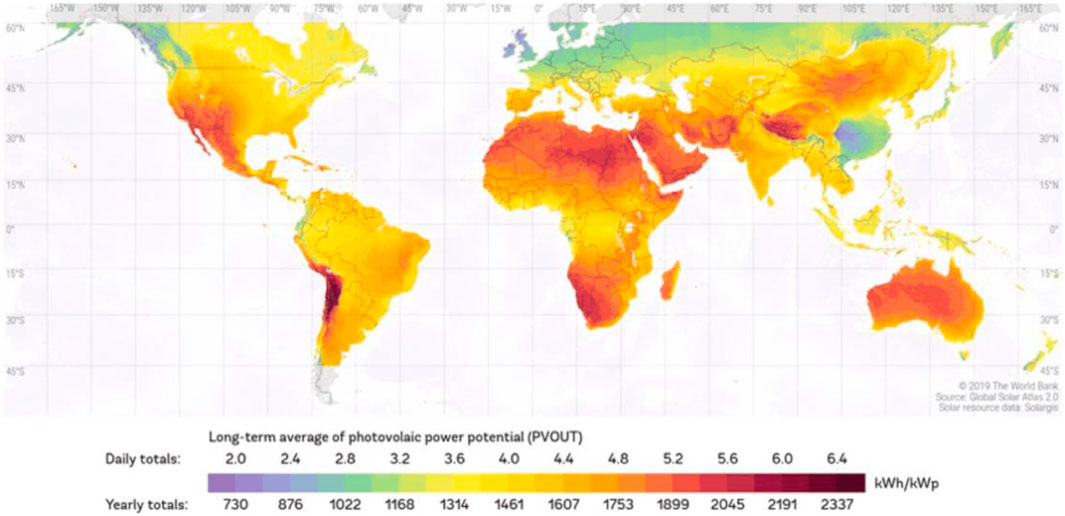
Figure 1. Geographical dispersion of solar resources on a global map Duvenhage (2019).
Three categories of power predicting models are commonly used in the design of electricity power distribution and supply systems: 1) short-term techniques, which provide predicts up to 1 day/week in advance; 2) medium-term models, which extend predictions up to 1 year ahead of time; and 3) long-term models, which have predicted exceeding 1 year Pedregal and Trapero (2010). Ramp events-rapid variations in solar irradiance-are important for very short- and very short-term prediction timeframes. The dependability and quality of PV electricity may decline with sudden and intense fluctuations in solar irradiation. As a result, the best PV power ramp rates can be determined using the results of short-term predictions Lappalainen et al. (2020). Moreover, the enhancement of operational efficiency and market involvement is contingent upon the use of long- and medium-term predicting Husein and Chung (2019). Predictions of day-ahead solar irradiance have proven effective in maximizing annual energy consumption for business operations in microgrids. Consequently, it becomes necessary to modify solar energy projections using a suitable predicting approach and to customize them according to particular applications.
The literature has been overflowing with studies of Saudi Arabia’s wind energy sector in recent years. As Baseer et al. (2017) points out, these studies primarily analyze statistical factors related to various wind farm sites, frequently deriving Weibull distribution parameters for each site. Nevertheless, a significant drawback of this research is their dependence on general evaluations of the available wind speed data for specific locations. As a result, their site productivity results can bespeak that a site is not ideal for a wind project at this time, even though it might be suitable in the future. These studies frequently rely on the presumption that a universal strategy that uses the Weibull distribution works well at every location. This assumption lacks validity and accuracy due to the intrinsic diversity among sites, which could result in over-approximations Ouarda et al. (2015). Interestingly, none of these studies-to the best of our knowledge-have taken into account the addition of wind speed data gathered from other, geographically dispersed places. The lack of such an approach misses the chance to handle these disparate data sets as a single, cohesive package while maintaining the location-based relationships. This comprehensive viewpoint, which is mainly lacking in current research efforts, has the potential to engage in more correct and thorough standard assessments of wind speed productivity at different sites. This paper’s main contribution is to address this specific aspect. The study that is being presented makes use of cutting-edge Artificial Intelligence (AI) approaches that have been widely used in a variety of disciplines. AI is widely used because of its natural benefits in decision-making and model-building Almutairi et al. (2016).
AI techniques have been applied to the research of renewable systems in many studies. The author Almonacid et al. (2010) utilized artificial neural networks to describe solar modules. Other research makes use of data mining methods like fuzzy logic and Support Vector Machines (SVM). Adaptive fuzzy inference systems and Gaussian-kernel SVM are combined in a novel way in Abukhait et al. (2018) to derive fuzzy rules straight from training data for use in testing phases later on. The authors Mansour et al. (2019); Mansour (2018) use of SVM, Artificial Neural Network (ANN), Naïve Bayes, and Decision Tree (DT) is investigated for the analysis of electroencephalography signals in the diagnosis of epilepsy. Furthermore, to detect bad medication reactions, Mansour (2018) use the decision tree technique. A Genetic Algorithm (GA) is then used to optimize the system.
One of the most important steps in attaining a high degree of grid integration of renewable energy is the construction of a comprehensive and centralized Solar and Wind Energy Prediction System (SWEPS). Several essential elements must be included in the improvement of such a method:
The important frameworks embedded into the SWEPS consider
This study lays the foundation for a comprehensive Solar and Wind Energy Predicting System by carefully examining the existing functional frameworks of renewable energy. Using advanced web interface solutions, sustainable energy models, climate predicting modules, and daily updates on solar and weather predictions; SWEPS is designed to effectively monitor the efficiency of various green energy situations. Regular use of this technology will enable grid operators and key players in the Saudi energy sector to provide forward-looking power supply estimates daily. Key objectives include maximizing the current operational locations of RES by facilitating their integration into the unified grid interface while understanding the challenges of connecting or maintaining solar energy systems within the same systematic framework. Additionally, through collaboration with companies such as Elia Grid International, Khalifa University of Science and Technology, and King Abdullah City for Atomic and Renewable Energy (KACARE); Our system advances research by supporting green energy platforms across the region.
In this study, the SWEPS is developed for predicting wind and solar energy. The various data collected across multiple channels is refined and standardized using various pre-processing methods, including deep learning and machine learning algorithms, to predict results. After the initial processing phase, a series of techniques related to Statistical Correlation Analysis (SCA) are used to identify relationships and links between aspects. Least Absolute Shrinkage and Selection Operator (LASSO), Recursive Feature Elimination (RFE), Principal Component Analysis (PCA), Recursive Feature Addition (RFA), and Genetic Algorithm for Feature Selection (GAFS) are some of the techniques used in feature selection. In addition, Cuckoo Search Optimization (CSO), Social Spider Optimization (SSO), Particle Swarm Optimization (PSO), and Neural Network Algorithm (NNA) are GA used to optimize the prediction model to improve its robustness.
The SWEPS represents a significant advancement and contributions in the following.
Section 1 delves into the latest advancements in Solar and Wind Energy Networks and preprocessing methodologies for Renewable Energy Systems, providing a comprehensive review of cutting-edge works. A summary of the SWEPS is given in Section 3, followed by an examination of the methodological analysis in Section 3.6, methodology development and outcomes in Section 4, and research conclusion and future initiatives in Section 6.
2 Motivation and aims
Predicting solar energy production remains a major hurdle due to the inherent inaccuracies of existing predicting methods, especially when it comes to anomalies in the solar and wind data. Factors such as inconsistencies in energy measurements, inaccurate climate categorization, and variable predicted horizons contribute to unreliable solar intensity predictions. The urgent need for a robust and reliable predicting system that directly addresses these challenges is clear when considering the critical role that solar predictions play in the planning, management, and operation of the global power grid.
In this work, an SWEPS is introduced and presented, an innovative and comprehensive approach to revolutionizing the accuracy and reliability of solar energy prediction. Current predicting techniques often miss the mark due to their limited scope of application. The SWEPS addresses this problem head-on by carefully considering every detail, from the path of the sun to atmospheric fluctuations. This manuscript addresses the complex architecture of SWEPS and shows its dependence on optimization strategies and state-of-the-art preprocessing techniques such as PCA, RFE, LASSO, and RFA-GA. It also highlights how the SWEPS SCA seamlessly integrates with advanced deep learning algorithms. Additionally, it highlights how genetic algorithms such as CSO, SSO, PSO, and NNA are used to refine search criteria and improve model predictability, ultimately paving the way for more accurate and reliable solar energy predictions.
Our dataset’s intricacy and time-series format necessitated a multipronged feature engineering strategy. To make sure the most important features were included, the Intersection over Union (IoU) technique is used in conjunction with a range of customized feature engineering techniques. This strategy made it easier to combine comparable information from several approaches, which improved the overall precision and resilience of our models. In an ensemble framework, also certain machine learning approaches are adopted such as ANN, DTs, and SVM to capitalize on their distinct advantages. Furthermore, deep learning methods are adopted and used that are especially well-suited for time-series forecasting, such as RNN and LSTM networks. By combining these techniques, we were able to develop a thorough prediction system that would function dependably under different circumstances.
Lastly, we highlight the significance of using meta-heuristic optimization approaches to fine-tune our machine learning models’ hyperparameters. To efficiently explore solution spaces, methods like SSO, PSO, CSO, and NNA imitate natural processes. Models like as SVM, DTs, ANN, RNN, and LSTM perform better with this method because it achieves near-optimal hyperparameter values, which guarantee strong convergence and increased accuracy. SWEPS is a vital component for efficient planning and control of the worldwide power grid because it integrates these cutting-edge methodologies to considerably increase the prediction accuracy and dependability of solar and wind energy projections.
3 Proposed design and methodology
This article introduces SWEPS, a novel system for predicting solar and wind energy production. SWEPS addresses data heterogeneity from different sources using a multi-stage process. Algorithm 1 describes the complete process of the proposed methodology. First, it refines and standardizes the data using a powerful combination of deep learning and traditional machine learning algorithms. This pre-processing ensures a clean and consistent basis for subsequent analysis. After the cleaning phase, SWEPS deals with the selection of functions and uses a diverse arsenal of techniques. RFE, PCA, RFA, LASSO, and GAFS. They work together to identify the most impactful features. To illuminate important connections and eliminate redundancies. The optimization of the prediction model takes a central place in the final phase. By using evolutionary algorithms such as GA, SWEPS explores innovative NNA, PSO, SSO, and CSO. This rigorous optimization process improves the robustness of the model and enables it to provide accurate and reliable predictions, ultimately improving grid stability and renewable energy integration.
The SWEPS system, depicted in Figure 2, uses deep learning and machine learning methodology to predict energy usage and production. In the initial step, the dataset from various sources is collected, and remove errors and noise. For normalization, different methodologies are used such as replacing missing values, min-max operation, and standardization on the numerical data. To calculate the correlation, between features, and the selection of optimal features for analysis, we use SCA, RFE, RFA, LASSO, and GAFS to find the optimal correlations. After feature selection, different traditional machine learning algorithms are applied such as SVM, DT, and Neural Networks. Further, we apply the deep learning technique RNN, and LSTM and ensemble these algorithms. To robust our system, optimization algorithms is applied such as NNA, PSO, SSO, and CSO to get the optimal results from the algorithms.
3.1 Dataset
We used large datasets of hourly high-resolution solar radiation observations from several years ago, with a combined raw data size of several terabytes. For us to train and validate our deep learning models, such as LSTM and RNN, this massive dataset was essential. It made it possible for us to accurately estimate solar activity and to record temporal dynamics efficiently. The size of the dataset also made it easier to use ensemble methods and meta-heuristic optimization algorithms (PSO, CSO, SSO), which improved our predictions even more. A statistical statement of the data composed at each site is shown in Table 1, which includes indices that provide important information about the location and variability of the data. To help with interpretation, brief descriptions for a few of these statistics are Mean, Standard Error, Median, Mode, Standard Deviation, Sample Variance, Kurtosis, Skewness, and Minimum and Maximum values. The most popular measure of central tendency for a random variable is the mean, which is the average number of data points. Except for the east area, where the recorded mean is 1.9 m/s, the means across the chosen sites range from roughly 3 m/s to 4 m/s. All sites show standard errors below 5%, indicating adequate sample representation. Central tendency measures include median and mode. Standard deviation, variance, kurtosis, and skewness assess data distribution characteristics. Minimum and maximum values denote dataset extremes. Sum and count reveal the total wind speeds and the number of data points. Due to variances in local weather and distances, the data shown in Table 1 show considerable statistical value fluctuations among sites.
The information is a component of the KACARE’s Renewable Resource Monitoring and Mapping program. At many locations around the Kingdom of Saudi Arabia, KACARE methodically observed and recorded wind speed data at a height of 3 m. A sample dataset from the different sites is shown in Table 2. The accuracy and degree of confidence in the wind speed estimate are largely dependent on the sample size. Estimates of wind speed are inherently imprecise, and this uncertainty is impacted by the unpredictability of the data as well as sample size; larger samples decrease the uncertainty, while smaller samples increase it. A sample dataset from Qassim University (QU), in Qassin Region in Saudid Arabia as depcited shown in Figure 3, is shown in Table 1, with sample sizes varying from 19,000 to 25,000 data points. To reduce the degree of uncertainty in wind speed estimates, larger samples are purposefully obtained. To tackle outliers, preprocessing involves k-means clustering. It should be noted that the data mining uncertainty is addressed via decision tree methodology, notably Gini impurity and entropy metrics.
In Table 2, the number of missing records for each dataset column is displayed in the table. There are large gaps in variables like Wind Direction at 3 m, Wind Speed at 3 m, and related uncertainty. The number of missing values varies depending on the parameter. The information provided makes clear the data gaps that must be taken into account and handled appropriately while analyzing and interpreting the dataset.
3.2 Preprocessing
After a comprehensive examination of the dataset assembled from multiple locations, our data analysis revealed the presence of missing values. To address this issue described in Table 2, we applied certain techniques to numerical and categorical features in our data cleaning strategy. We decided to use imputation for numerical features where data were missing and replace the missing values with the mean of the corresponding features. This helps configure the overall statistical properties of the data set. Instead, we chose to use the mode representing the collection with the highest frequency to fill in missing values for categorical features. This methodology ensures that classification information is presented meaningfully.
After removing missing values, we then standardized all data. When data is normalized, it is transformed so that its mean is zero and its standard deviation is one. Especially when working with algorithms that are sensitive to the scaling of the input variables, this step is essential to ensure that all features contribute equally to the analysis. We have aggregated data from multiple sources into a consistent format to enable in-depth examination across multiple locations. This integration enables meaningful comparisons and analyzes and enables a consistent and consistent presentation. Additionally, we used data normalization techniques to guarantee that numerical values from respective features and locations are immediately comparable. By measuring the mathematical values to a similar range, usually between 0 and 1, normalization removes any potential biases brought about by assorted scales. By taking this step, comparisons are more reliable and the total dataset is interpreted more accurately.
In our careful data analysis, we paid particular attention to dealing with skewness and missing values in columns related to key weather variables. The air temperature
Algorithm 1.Solar and wind energy prediction system (SWEPS).
1:
2:
3:
4:
5: for alloptimized_results
6:
7:
8:
9: end for
10:
3.3 Statistical correlation analysis
The linear relationship between two continuous variables is measured by the PCC. We may be curious to know the correlation between variables like Air Temperature, Wind Speed at 3m, and Relative Humidity in the context of our dataset. For instance, a positive Pearson Correlation Coefficient (PCC) between temperature and solar radiation would suggest that there is a tendency for solar radiation to rise with temperature. In a similar vein, a negative PCC between temperature and wind speed may indicate an inverse link. The positive association between solar radiation and air temperature follows that solar radiation tends to rise along with air temperature. This is because warmer weather usually means more sunshine and, thus, more solar radiation. A positive PCC value for the association between the variables air temperature and solar radiation that is close to 1 would support the hypothesis that they are positively connected. A negative correlation between temperature and wind speed suggests an adverse relationship. To put it another way, there may be a drop in air temperature and a spike in wind speed. One possible explanation for this connection might be that higher wind speeds provide the illusion of a lower temperature. A negative PCC value would indicate a potential inverse relationship between Wind Speed at 3 m and Air Temperature. When the value of PCC gets closer to −1, the negative link becomes stronger.
In Figure 4, the PCC and Spearman Rank Correlation Coefficient (SRCC) were applied to visualize the relationship between different meteorological features such as air temperature, relative humidity, wind direction, and speed. The values present strong and weak correlations. Positive values indicate a strong correlation and negative values show negative correlations.
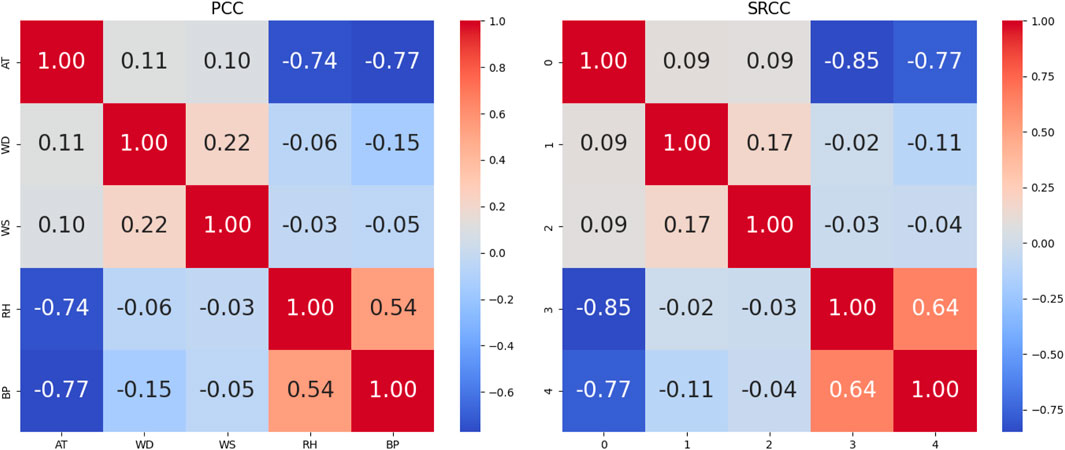
Figure 4. Application of PCC and SRCC to visualize the relationship between different meteorological features.
The monotonic relationship between two variables is evaluated using the SRCC. When working with non-linear relationships, it is quite helpful. Even in cases when the connection between the variables in the dataset is not strictly linear, SRCC can assist in determining whether the variables collectively show a consistent rise or fall in value. Compared to PCC, the rank-based correlation metric SRCC is less susceptible to outliers. The SRCC takes into account the ranks of these values rather than the variables’ actual values. It can withstand extreme values or non-linear relationships because of this. Although the SRCC results may have different numerical values, they should be interpreted similarly to the PCC results. The monotonic relationship between the variables and the correlation direction (positive or negative) should coincide. The SRCC measures the monotonic relationship which should continuously increase and decrease and it does not necessarily have to be linear. It will find the trends between variables which one is falling and rising in proportion to the other. The SRCC values which are near −1 or 1 indicated strong monotonic relationships. When one variable rises, the other tends to rise as well, according to positive SRCC, and when one variable rises, the other tends to fall, according to negative SRCC.
The degree of link between categorical variables is measured using Cramer’s V. We used to analyze the relationship between categorical variables in your dataset, like Wind Direction at 3 m and Wind Speed at 3 m. Between 0 and 1, Cramer’s V denotes the absence of any correlation between the category variables. The Cramer’s V value in the context of wind direction and wind speed should be around zero if there is no regular link between the direction and speed. The Cramer’s V value should be around zero if the wind’s direction and speed are unrelated. A high degree of correlation between categorical variables is indicated by a Cramer’s V value near 1. This would suggest that there is a distinct and well-established link between wind direction and wind speed. The Cramer’s V value should be very near to 1 if wind direction and wind speed are strongly correlated. The consistency or dependability of measurements is evaluated using the Intraclass Correlation Coefficient (ICC). You can use the ICC function in your dataset to determine the degree of consistency in readings for variables such as Air Temperature and Wind Speed at 3 m across several sites. In
3.4 Feature engineering
The main objective of this research is to use data from an Solar and Wind Energy (SWE) located at Qassim University in Saudi Arabia to anticipate SWE power generation. Three different kinds of factors that are pertinent to the study location are used to train different models to get the most accurate SWE power production prediction. The literature has shown that temporal parameters, meteorological circumstances, and historical SWE power-generating data have a significant impact on SWE output. The input variables used in this study are listed in Table 2. As an example, the air temperature (
The target column is removed from the dataset before it is imported into a unique format to create the feature matrix, represented by the letter X. After that, PCA is performed to X, converting the data into a space with fewer dimensions. To help with the decision of how many components to keep, it includes a plot depicted in Figures 5, 6, that shows the cumulative explained variance ratio against the number of principal components. To further visualize the data in the condensed space, optional 2D and 3D scatter plots are generated. A deeper comprehension of the dataset’s underlying structure is made possible by these visualizations, which provide insights into the patterns and relationships found within it.
In Figures 5, 6, the additive elaborate variance ratios for all important elements obtained from PCA are presented in this figure. The number of primary components is plotted on the x-axis, while the cumulative explained variance ratio is plotted on the y-axis. The plot aids in figuring out the ideal number of primary components required to preserve a sizable portion of the original dataset’s content.
The determined computer and a planned amount of selectable features are used to format RFE. After fitting the RFE model to the data, a horizontal bar chart is used to illustrate the ranking of features and help determine which features are most important in predicting the” Diffuse Horizontal Irradiance (DHI)
Feature Rankings via RFE for Predicting Solar and Wind Energy. The significance of each attribute in predicting DHI with the Random Forest Regressor as the estimator is displayed as a horizontal bar plot. Features are rated according to how well they predict the model performs, which helps identify the important factors affecting solar radiation. RFE is a useful approach for feature selection since it keeps the most important variables in the model, improving interpretability and possibly optimizing prediction accuracy.
Initially, the selected and objective feature is removed from the source dataset and the remaining features are there in the dataset for analyzing and predicting the objective features. Using
The complicated dynamics and time-series character of our data in our study made it difficult for us to use a single strategy for feature engineering. A variety of feature engineering strategies is used that were adapted for our particular dataset to solve this. Every unique method extracted pertinent characteristics that are essential to our prediction model. The Intersection over Union (IoU)approach is used to make sure the most relevant and appropriate characteristics were included. By locating and combining similar features from different engineering methodologies, IoU made it easier to integrate features. By using this strategy, we made sure that our prediction system had access to a wide range of information that improved our models’ overall accuracy and resilience and increased our capacity to accurately forecast the dynamics of solar and wind energy.
As in Section 3.4 the effect of each feature on the target variable “DHI (Wh/m2)” is illustrated in this bar chart, which shows the coefficients derived from the LASSO regression model (Figures 8, 9). The magnitude of the coefficients is represented by the x-axis, with positive and negative values representing the direction and strength of the connection, respectively. Features with non-zero coefficients significantly increase the predictive ability of the model and help identify important factors in predicting solar radiation.
3.5 Machine learning algorithms
Gaining knowledge about these linear correlations will help you better understand how solar irradiance behaves and the elements that influence it. For instance, clear skies, lower relative humidity, and higher air temperatures are often linked to high solar irradiance (GHI and DNI), but overcast days with greater humidity might result in higher diffuse irradiance DHI. The zenith angle, wind direction and speed, and barometric pressure all have a major impact on how weather patterns shape solar energy availability. Improved models for forecasting solar irradiance and optimizing renewable energy systems may be created by examining these correlations.
The key to determining how changes in one variable might affect another is to comprehend the linear relationships between the columns depicted in Figure 10, ‘Air Temperature (C
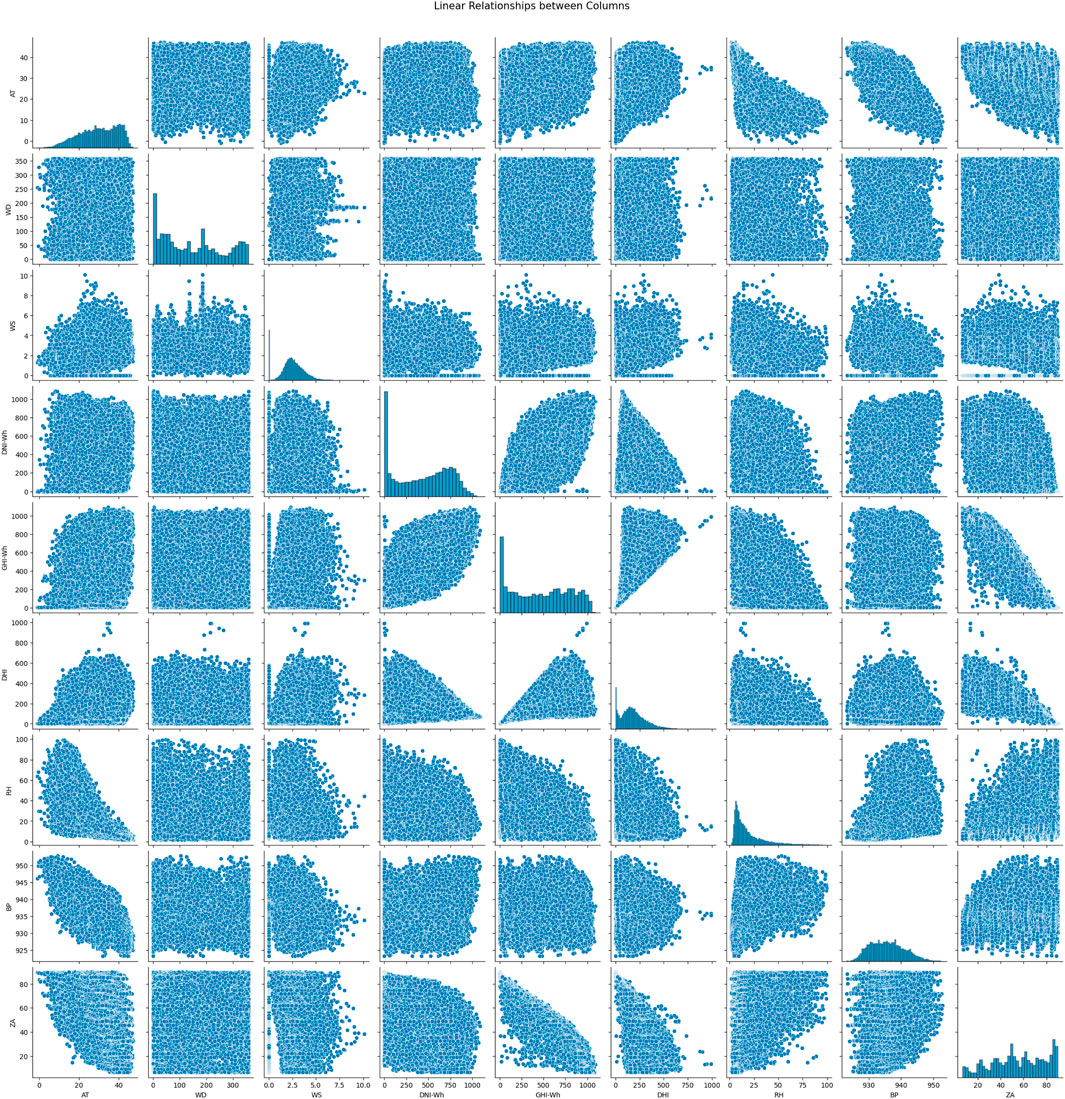
Figure 10. Solar irradiance correlates with meteorological variables like temperature, wind, humidity, and atmospheric pressure. Higher irradiance GHI aligns with increased temperatures and clearer skies, boosting both diffuse DHI and direct DNI irradiance. Wind affects humidity and cloud dispersion, influencing irradiance. Solar angle impacts intensity, while humidity scatters light, enhancing DHI. Barometric pressure links to humidity: low pressure increases cloudiness, while high pressure clears skies. These relationships refine solar energy prediction models.
The zenith angle also affects GHI because irradiance is often increased at lower angles. Relative humidity and DHI have a noteworthy relationship because high humidity can scatter sunlight, boosting DHI even in the presence of cloud cover, which lowers GHI and DNI. Weather systems influenced by barometric pressure have an impact on humidity levels; high-pressure systems are often linked to clear skies and reduced humidity, while low-pressure systems are linked to higher humidity and cloudiness. Additionally, through cloud cover and irradiance levels, there is an indirect link between relative humidity and the zenith angle. Since low-pressure systems can be warmer, high-pressure systems are often associated with cooler temperatures because of radiative cooling and clear sky. A surface’s exposure to solar radiation is directly influenced by its zenith angle; a lower zenith angle (the sun is higher in the sky) means a higher irradiance. These linear correlations shed important light on how solar irradiance behaves and what influences it. For example, DHI might be higher on overcast days with increased humidity, whereas high solar irradiance (GHI and DNI) is often linked with clear sky, reduced relative humidity, and higher air temperatures. The zenith angle, wind direction and speed, and barometric pressure all have a major impact on how weather patterns shape solar energy availability. Improved models for forecasting solar irradiance and optimizing renewable energy systems may be created by examining these correlations.
A decision tree effectively divides the input space of a data set into different, non-overlapping parts and gives each region a different name. The decision tree starts from the root node and reaches the last leaf nodes Perez et al. (2013), with multiple branches connecting these locations. The algorithm makes decisions by iteratively dividing the data into multiple parts and then dividing each region into even smaller partitions. The elimination operations are recursively executed until we reach the last node. The contamination metric is the default-based partition. In our study, the main measurement metric is entropy and it finds the homogeneity between separated nodes. The finding of entropy is a recursive step-wise procedure in decision tree algorithm and it is controlled by Gini Index and entropy as the primary scale of impurity. The depicted Equations 1, 2 is a group of mathematical equations that depicts the requirements of separating nodes from the root and constructing a decision tree. To find the measures of impurity via entropy (H) and the Gini Index (GI), the depicted Equations 1, 2 completely rely on it. The Gini index for a given tree node can be found as follows:
where
where
For regression and classification problems, one of the widely applied algorithms is SVM. In our system, we apply to predict the solar and wind energy, and to robust our proposed system. The main agenda of SVM is to search for the optimal hyperplane in a high-dimensional space to partition data points. For binary classification problems, Equation 3 for predicting solar and wind parameters is written as follows:
Here,
Even in the absence of data, ANN, computer models designed on the structure of the human brain, can successfully predict solar and wind hidden patterns. The general ANN equation depicted in Equation 4
Here,
One kind of artificial neural network that works particularly well for training sequential or time-series data is the RNN, which is capable of handling time-series data, which includes important temporal information, in contrast to Simple Neural Networks Hüsken and Stagge (2003). To represent input at various time intervals, RNN deconstructs sequences into their parts and keeps a state Hochreiter and Schmidhuber (1997). The RNN structure, comprises inputs, hidden neurons, and an activation function. Equation 5 defines the preceding hidden layer (
In this case, the input is denoted by
An improved version of the RNN, the LSTM network addresses problems with long-term data dependencies and time-series predicting, which are frequently hampered by gradient explosion and vanishing gradient problems. The LSTM architecture in Figure 6 comprises inputs, memory cells, outputs, and forget gates that act collectively to control information flow. The forget gate splits what should be retained and discarded. The output gate ascertains the subsequent hidden state, whereas the input gate updates the cells. By producing values between 0 and 1, sigmoid functions trigger the gates, allowing information to get through only in certain cases. Equation 6 describes this mathematical structure in detail:
The sigmoid activation function is represented by
Using the sigmoid activation to identify values to compose and the tanh activation function to update the gate with new cell values, the input gate
A feature ensembling algorithm that concatenates features from DT, SVM, ANN, and RNN with features from other deep learning models. By combining the advantages of several models, this strategy seeks to produce a more reliable and accurate prediction system for solar and wind parameters. The specific features that are highlighted-DHI, DHI Uncertainty, DNI, DNI Uncertainty, GHI, and GHI Uncertainty-are the main emphasis of the assembling process. RNN and LSTM are good at identifying temporal and sequential patterns in time-series data, which makes them appropriate for features such as air temperature, wind direction, and wind speed (Figures 11, 12). Ensembling is the process of combining the pertinent features that are taken out of RNN and LSTM models, probably including some that have to do with the intrinsically temporal nature of wind and solar data. Non-linear correlations and interactions between features can be handled via decision trees. SVM performs effectively in high-dimensional areas and has good data handling capabilities. An ANN is a flexible model that can extract intricate patterns from data. These models probably make use of latitude, longitude, and atmospheric parameters (such as pressure, temperature, and humidity). Concatenation of relevant features from the standard models (DT, SVM, ANN) and deep learning models (RNN, LSTM) is performed. With this combination of features, deep learning, and conventional machine learning techniques are used to capture an extensive set of data. Combining the predictions of separate models-possibly using methods like weighted voting, stacking, or averaging-is the ensembling process. Important solar irradiance metrics that indicate various portions of sunlight that reach the Earth’s surface are DHI, DNI, and GHI. The uncertainty values offer valuable information regarding the dependability of the relevant measurements of irradiance. Incorporating these elements guarantees that the assembling procedure takes into account the minute nuances of solar radiation, which is necessary for precise solar and wind predicting. To provide a more authentic and precise solar and wind predicting system, the assembly process involves balancing the different capabilities of traditional deep learning and machine learning models. The prediction model is generally more reliable because taking individual characteristics into account ensures that the peculiarities of solar radiation intensity are carefully taken into account.
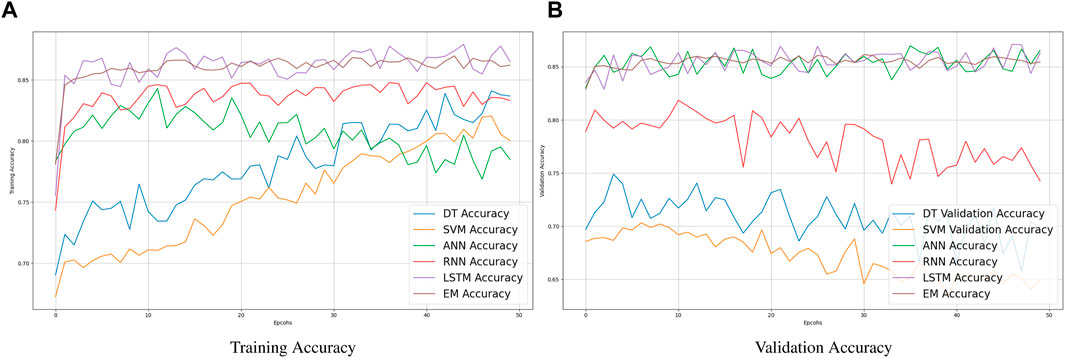
Figure 11. Comparative Analysis of training and validation accuracy of various learning models: Assessing the performance of traditional machine learning algorithms (DT, SVM, ANN), deep learning algorithms (RNN, LSTM), and EM models. Results showcase model accuracy without the application of optimization algorithms.
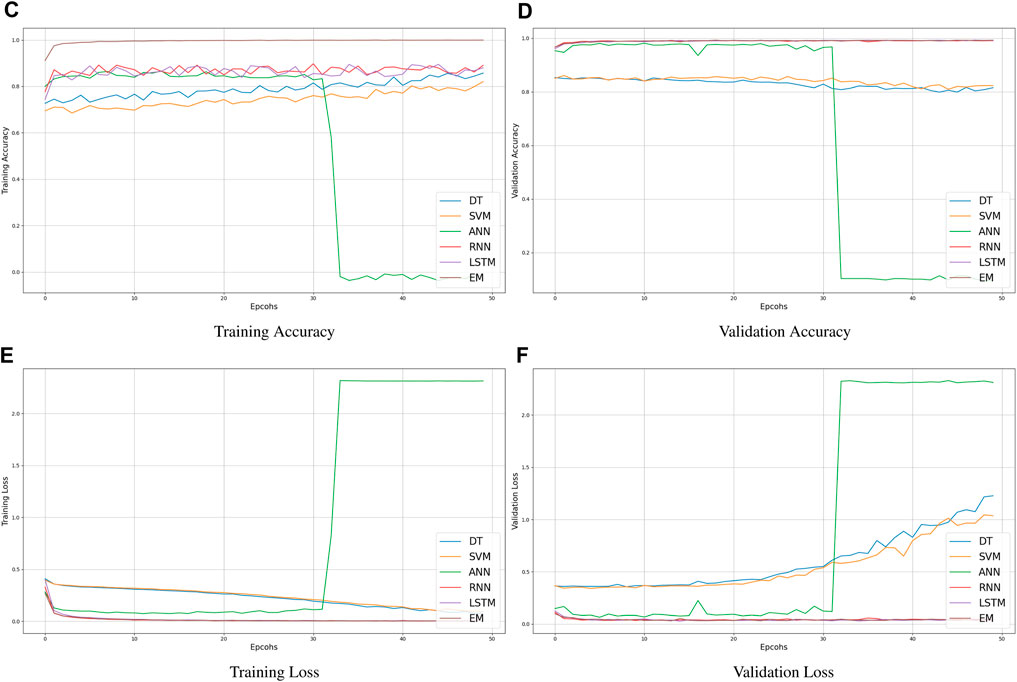
Figure 12. Training and Validation Accuracy of learning models: We use different traditional machine learning algorithms (DT, SVM, ANN) and deep learning algorithms (RNN, LSTM) and EM models. The results are obtained without optimization algorithms.
We used specific machine learning methods such as Decision Trees, Support Vector Machines (SVM), and Artificial Neural Networks (ANN) in addition to an ensemble approach to combine their advantages. This ensemble approach uses the unique strengths of each model to capture various aspects of the dataset, hence increasing the prediction potential. To be more precise, SVM is good at establishing intricate decision boundaries in high-dimensional spaces, whereas Decision Trees are good at exposing nonlinear connections and interactions among features. By extracting deeper insights from data, ANN enhances these models with its adaptability in learning complex patterns. Our goal in assembling these conventional machine learning algorithms was to obtain a thorough comprehension of solar and wind energy forecasts.
Furthermore, we expanded this strategy to incorporate deep learning techniques including Long Short-Term Memory (LSTM) networks and RNN. Because RNNs are designed to handle sequential data, they are appropriate for time-series forecasting, which is a necessary component of solar and wind energy prediction. Long short-term memory networks (LSTMs), which are well-known for managing long-term dependencies, significantly improve the model’s capacity to accurately represent temporal dynamics. We combined the complimentary characteristics of these deep learning architectures with the conventional models to create a single prediction system. Our prediction models for solar and wind energy are more reliable because to this combination of deep learning and machine learning techniques, which guarantees stable performance across a range of circumstances.
Accurate tuning of hyperparameters is crucial to the performance of machine learning models, including DT, SVM, and LSTM. For SVM, the regularization value C is normally between 0.1 and 1000 to account for training and testing errors. The kernel factor
3.6 Optimization methodology
Machine learning models like SVM, DT, ANN, RNN, and LSTM perform better when meta-heuristic optimization algorithms like SSO, PSO, CSO, and NNA are used. By rapidly exploring and exploiting solution spaces, these optimization algorithms are made to resemble the behaviors of natural systems, which enables them to identify near-optimal solutions in high-dimensional, difficult situations.
SSO uses a traditional hunting style Social Spdier’s to train the model. During learning, it animates the sub-spider to analyze together and boost the performance of a model using feature engineering. Through more efficient solution space exploration, SSO aids in the discovery of ideal hyperparameters for SVM, DT, ANN, RNN, and LSTM. The SSO equation is depicted in Equation 12 for spider (i) exploration:
where
In searching for the best possible outcomes, the PSO depicted in Equations 13–15 simulates how a particle swarm might work. It applies to adjusting the hyperparameter weights in getting optimal results for RNN, DT, SVM, ANN, and LSTM models. It provides the ability to balance the exploration and production for optimal convergence and learning performance. For updating the position of the particle i and velocity are given by.
Where
The reproductive parasitism of some cuckoo species was used as a model for the CSO presented in Equation 16. It is used to replace worse solutions with better solutions to optimize the model parameters. CSO helps you efficiently navigate the search space, avoid local optima, and build more accurate models in SVM, DT, ANN, RNN, and LSTM. The equation for updating the position
where
An NNA is a meta-heuristic inspired by the composition and functioning of the human brain. This works great for hyperparameters and neural network design optimization. When NNA is used with SVM, DT, ANN, RNN, and LSTM, it helps to find the best network configurations and improve model accuracy. By integrating these meta-heuristic optimization algorithms into the training and optimization processes of machine learning models, the benefits of advanced exploration of the solution space enable the identification of optimal hyperparameters and model configurations. This results in better performance across a wide range of tasks, making models more adaptable and efficient, and capable of producing reliable results in real-world applications.
Meta-heuristic optimization techniques require careful tuning of hyper-parameters to produce meaningful results. The scaling factor
3.7 Measurement metrics
When evaluating the performance of machine learning models such as SVM, DT, and LSTM networks, the measurement parameters listed below in Equations 17–22 are essential.
The Mean Absolute Error (MAE) between the actual values (
4 Experimental results
The number of neurons in hidden layers is an important step in the context of
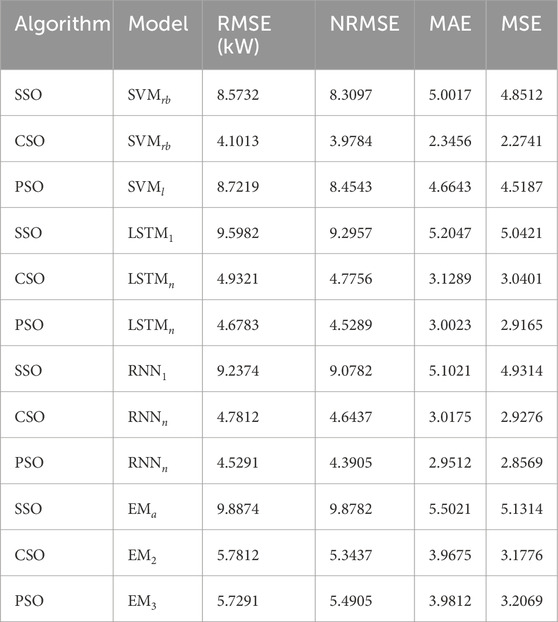
Table 3. Comparison of predicting Models Using SVM, LSTM, RNN, and EM with Meta-Heuristic Algorithms (SSO, CSO, PSO with single feature (DHI
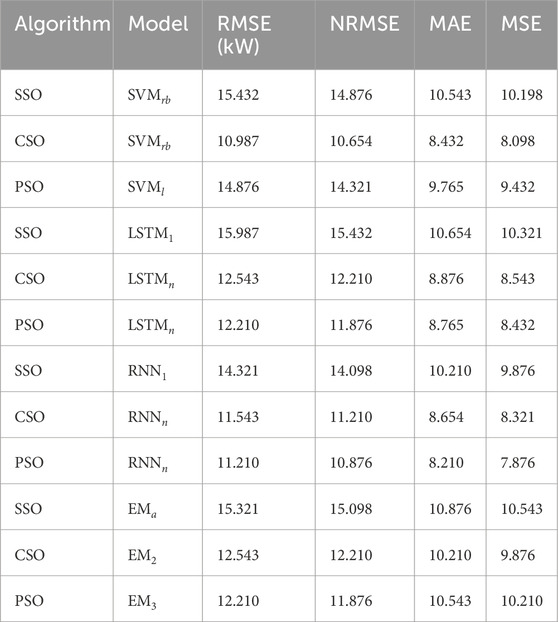
Table 4. Assessment and Comparison of the SVM, LSTM, RNN, and EM as predicting models with unique features (Wind Direction at 3m, GHI
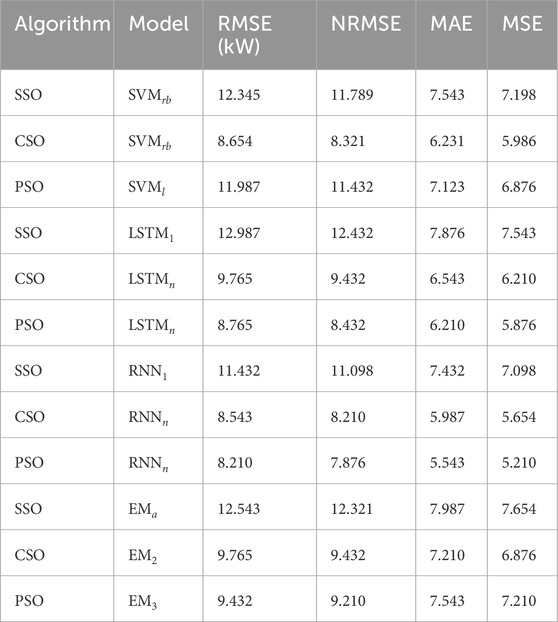
Table 5. Achievement analysis of SVM, LSTM, RNN, and EM as predicting models with distinct features (Wind Direction at 3 m (N), DHI
In this section, we address the analysis and debate about the effectiveness of current solar irradiance prediction models based on deep learning. Currently, the most popular method for predicting solar radiation intensity is the LSTM. Its popularity comes from being a type of RNN that gives the network more storage capacity in addition to preserving data for later use. Because it can reveal long-term correlations within time series data and speed up the convergence of non-linear predictions, this model is often used for predicting solar irradiance. An LSTM model is developed in a noteworthy study Srivastava and Lessmann (2018) to use remote-sensing data to predict sun irradiance at 21 locations across the USA and Europe 1 day ahead of time. The accuracy of the proposed model is impressively improved by 52.2% when compared to the smart persistence model. Using LSTM to estimate solar irradiance 1 hour ahead of time at three USA locations, another study Yu et al. (2019) built on this to achieve the lowest RMSE predicting of 41.37
Tables 3, 6 present the performance of improved predicting models over default models using different kernels for SVM, different hidden layers (1, n) for LSTM networks, different hidden layers (1, n) for RNN, and different feature combinations for EM. SSO, CSO, and PSO are the optimization techniques used to fine-tune and improve these models. Three types of SVM are studied: SVM with a linear kernel (SVMl), SVM with a polynomial kernel (SVMp), and SVM with a radial basis function of the kernel. (SVMrb). The improved models optimized by SSO, CSO, and PSO perform better than their standard counterparts in several parameters, including MSE, RMSE, NRMSE, and MAE. Two configurations of the LSTM category were analyzed: LSTMn, which has multiple hidden layers, and LSTM1, which has one hidden layer. Prediction accuracy improves in terms of RMSE, NRMSE, MAE and MSE when LSTM models are optimized using SSO, CSO and PSO.
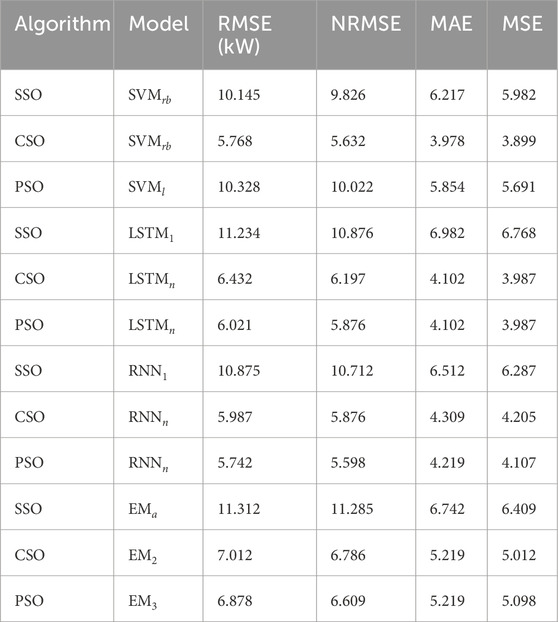
Table 6. SVM, LSTM, RNN, and EM performance evaluation of predicting models with multiple features (DHI
RNN1 and
LSTM and RNN are useful techniques that capture the intricate temporal patterns necessary for precise predictions in the field of solar radiation prediction. The LSTM architecture’s activation processes and memory cells help to learn long-term dependencies within time series data. A multi-horizon LSTM-based GHI prediction model performed very well in a recent research Mishra and Palanisamy (2018). The model’s RMSE is 18.57 W/
One method for dividing a dataset into a predetermined number of groups as depicted in Figure 13 using unsupervised machine learning is the grouping algorithm. To minimize the within-cluster variation, data points are repeatedly assigned to one of the k groups depending on their feature values. Each point in the graphic represents an observation from the dataset, displayed based on two chosen attributes, in the context of a pair plot with clusters. The clusters that the algorithm has allocated are denoted by different colors or markers. The x- and y-axes of each subplot in the pair plot represent distinct features, giving the data points a two-dimensional perspective. Each subplot in the pair plot represents a pairwise combination of the features in the dataset. For instance, if the dataset includes characteristics for relative humidity, air temperature, GHI, DNI, and other variables, the pair plot will display subplots for each paired combination of these features. Various colors or markers are used to symbolize different clusters; for example, blue circles may be used to symbolize Cluster 1, red triangles to symbolize Cluster 2, and so on. The algorithm’s determined centroids for each cluster may alternatively be shown on the plot as bigger or differently marked points.
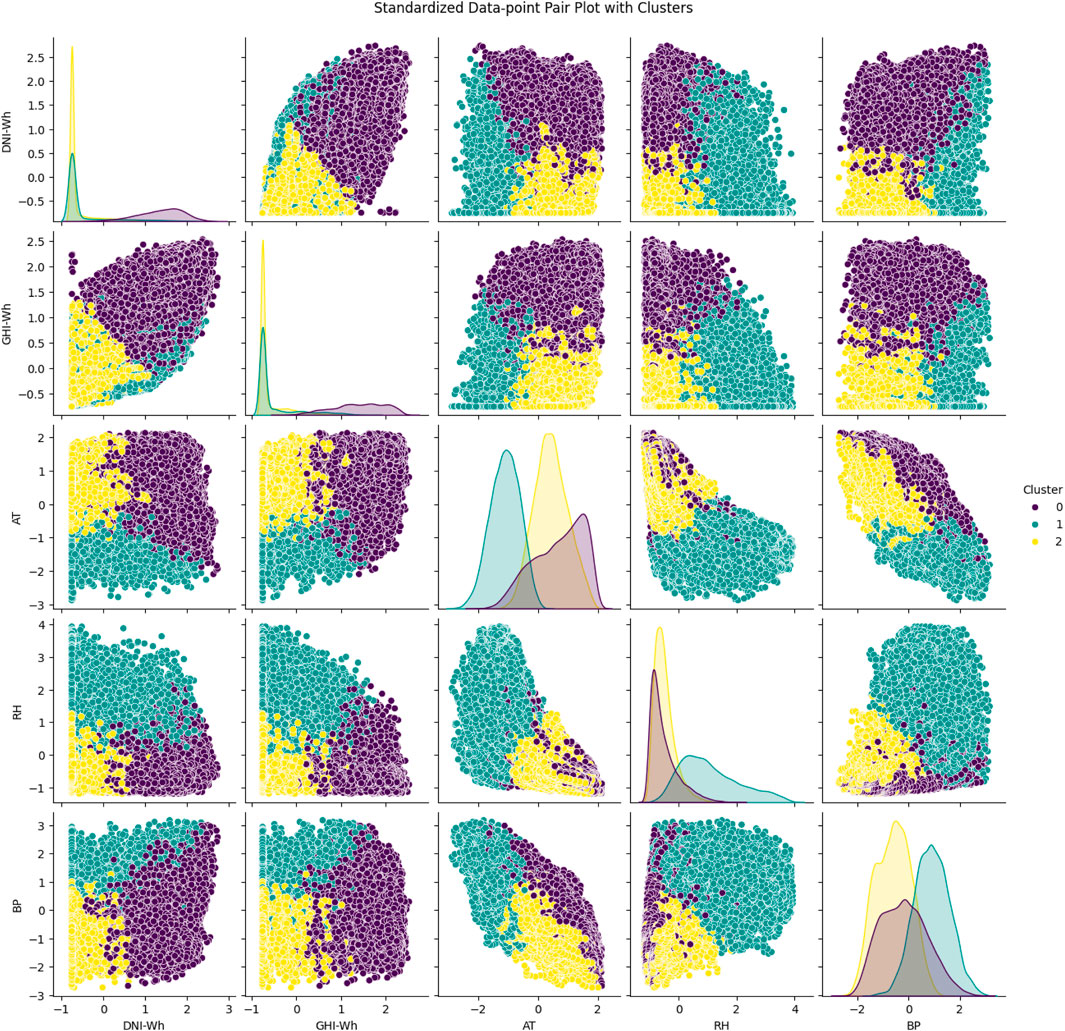
Figure 13. The pair plot, a tool for unsupervised machine learning, visualizes data grouping based on attributes like air temperature, humidity, DNI, and GHI. It shows correlations and cluster patterns, aiding in dataset understanding and improving renewable energy forecasts.
The pair plot facilitates the visualization of the degree to which the specified characteristics are used to divide the data points into clusters. While overlapping clusters may indicate that the characteristics do not give a clear distinction or that the number of clusters (k) needs to be changed, clean separation between clusters shows that the features used for the plot are successful in differentiating between various clusters. Based on the chosen attributes, each cluster collects data points that are comparable to one another, making it possible to visually evaluate the differences and similarities within and between clusters. One cluster may indicate low GHI and high relative humidity in a dataset including solar irradiance, whereas another cluster may represent high GHI and low relative humidity. The process of grouping data facilitates the discovery of underlying structures and patterns. Grouping may be used in renewable energy forecasting to classify various weather patterns, resulting in prediction models that are more precise and individualized. One may learn more about the interactions between various environmental elements and how they affect solar irradiance by examining clusters.
For clarification, let us suppose that we have four characteristics in our dataset: relative humidity (%), air temperature (C
A critical assessment of the trained Long Short-Term Memory (LSTM) model’s performance in predicting solar irradiance is given by Figure 14 titled “Predicted Hourly GHI for Test Data,” which shows a comparison between actual and predicted GHI values over 100 h Comprehension of the model’s performance in renewable energy forecasting and management requires a comprehension of this graphic. The GHI expressed in Wh/m2 is plotted on the y-axis of the image, while the x-axis displays time in hours over a total of 100 h. The ground truth measurements of solar irradiance at certain timestamps are used to create the real GHI values in the dataset, which are shown by the blue line. The anticipated GHI values produced by the LSTM model, on the other hand, are shown by the red dashed line. This is because the model has been trained to recognize temporal patterns in the dataset and is based on past data.
As shown in Figure 14, Showcasing the effectiveness of the trained LSTM model, the figure “Predicted Hourly GHI for Test Data” compares real and predicted GHI values over 100 h. Time is shown on the x-axis in hours, while GHI is shown on the y-axis in Wh/
As predicted from solar irradiance statistics, the graphic displays a distinct diurnal pattern because of the sun’s daily cycle. The graph’s peaks mark the times of day when solar irradiance is at its maximum, usually around noon, and the troughs, where the GHI values fall to almost nil, indicate nighttime or periods of low sunshine. The blue and red lines’ near alignment indicates how well the LSTM model can represent the temporal dynamics of GHI. The model has difficulties in areas where the lines diverge, such as abrupt changes in the weather or other anomalies not found in the training set. For solar power systems to operate as efficiently as possible, accurate GHI prediction is essential. This helps with improved grid stability, energy storage management, and solar power distribution. This chart illustrates the model’s performance, which implies that LSTM networks are useful for short-term solar irradiance predictions. This may result in the more effective and dependable integration of solar energy into the electrical system. The graphic clearly illustrates how well the LSTM model captures the innate patterns of solar irradiance and shows how well it can forecast GHI with a high degree of accuracy. This performance highlights how machine learning models, especially long short-term memory models, may improve the prediction and management of renewable energy sources. By tackling the unpredictability and uncertainty related to solar electricity, these predictive models help create more reliable and sustainable energy systems.
5 Limitations and future work
In light of their narrow range of applications, current prediction systems frequently fall short of expectations. Due to transitory clouds or other meteorological phenomena, short-term variations in solar irradiance may be missed by many forecast models that rely on hourly or daily averages. This may cause forecasts of solar power in real-time to be inaccurate. Forecasting models for solar energy output usually rely on information from a small number of weather stations or satellite observations, which might not be a reliable indicator of the local circumstances for particular solar powerhouses. Disparities between anticipated and actual energy output may arise from this. Weather patterns have a significant influence on solar energy output since they may be unpredictable and substantially shift over short time intervals. It can occasionally be challenging for conventional models to accurately represent this unpredictability, especially in places with complex weather patterns. The accuracy of prediction models is largely dependent on the accessibility and dependability of past weather and solar radiation data.
In areas where this type of data is scarce or of poor quality, prediction models could not function well. Many models may not accurately represent the intricacies of real-world systems as they rely on oversimplified assumptions about how solar panels and inverters operate in various scenarios. Variations in panel deterioration over time, soiling, and shading can all have a big influence on real performance. It takes more than simply solar irradiance to predict the output of solar energy systems; it also involves understanding how this output interacts with the larger energy grid. Demand response, energy storage, and grid capacity are a few examples of factors that are frequently left out of solar forecast models, which can cause supply and demand imbalances.
Although solar energy prediction has advanced significantly, there are still several areas that need more investigation and improvement. Future research endeavors may concentrate on enhancing the temporal and geographic resolution of prediction models by the assimilation of sophisticated machine learning algorithms with high-resolution meteorological data obtained from various platforms, such as satellite observations and ground-based sensors. Short-term projections may become more accurate with the use of enhanced data assimilation techniques, which integrate historical records with real-time data. Furthermore, studies into hybrid models-which fuse statistical techniques with solar radiation physics modeling-may produce more reliable forecasts. (Figures 15, 16). Future energy planning will need to investigate how climate change affects solar energy output over the long term and incorporate this knowledge into prediction models. The advancement of increasingly complicated models that take into consideration the operational complexity of solar energy systems, such as panel deterioration, shading effects, and interactions with energy storage systems, is another area that shows promise. Ultimately, multidisciplinary research that takes into account social, environmental, and economic aspects may be useful in creating energy systems that are more robust and sustainable. These developments will help the further integration of renewable energy sources into the world energy system in addition to improving the accuracy of solar energy forecasts.
6 Conclusion
This study delves into the intricate world of solar radiation prediction by employing advanced deep learning models (LSTM and RNN) and ensemble techniques. This work explores how these models capture temporal dynamics and leverage the collective wisdom of different learning approaches. Additionally, this study demonstrates that optimization algorithms (such as PSO, CSO, and SSO) can significantly improve the accuracy of solar activity prediction and feature extraction from time series data. Additionally, ensemble models, which are known for their flexibility, are highly effective in combining different processing capabilities to achieve robust prediction. By utilizing meta-heuristic optimization techniques, such as the proposed framework SWEPS additional potential has been unlocked, achieving even more accurate predictions. These findings are significant as they pave the way for the reliable integration of solar energy into the evolving energy landscape. They highlight the importance of accurate solar radiation estimates in meeting the increasing demand for RES. Beyond its theoretical implications, the suggested approach was successfully applied in a grid station, offering concrete proof of its usefulness in capturing solar energy. This application highlights how important this work is to enable the steady integration of solar energy into the ever-changing energy production environment. The proposed work also stresses the crucial need to assess solar radiation accurately to fulfill the growing demand for renewable energy sources.
Data availability statement
The data analyzed in this study is subject to the following licenses/restrictions: The data can be provided by KACARE. Requests to access these datasets should be directed to QXRhbGFsQHF1LmVkdS5zYQ==.
Author contributions
TA: Conceptualization, Data curation, Formal Analysis, Funding acquisition, Investigation, Methodology, Project administration, Resources, Software, Supervision, Validation, Visualization, Writing–original draft, Writing–review and editing. SI: Conceptualization, Data curation, Formal Analysis, Funding acquisition, Investigation, Methodology, Project administration, Resources, Software, Supervision, Validation, Visualization, Writing–original draft, Writing–review and editing.
Funding
The author(s) declare that financial support was received for the research, authorship, and/or publication of this article.
Acknowledgments
The Researchers would like to thank the Deanship of Graduate Studies and Scientific Research at Qassim University for financial support (QU-APC-2024-9/1).
Conflict of interest
The authors declare that the research was conducted in the absence of any commercial or financial relationships that could be construed as a potential conflict of interest.
Publisher’s note
All claims expressed in this article are solely those of the authors and do not necessarily represent those of their affiliated organizations, or those of the publisher, the editors and the reviewers. Any product that may be evaluated in this article, or claim that may be made by its manufacturer, is not guaranteed or endorsed by the publisher.
References
Abukhait, J., Mansour, A. M., and Obeidat, M. (2018). Classification based on Gaussian-kernel support vector machine with adaptive fuzzy inference system. margin 7, 14–22. doi:10.15199/48.2018.05.03
Al Garni, H., Kassem, A., Awasthi, A., Komljenovic, D., and Al-Haddad, K. (2016). A multicriteria decision making approach for evaluating renewable power generation sources in Saudi Arabia. Sustain. energy Technol. assessments 16, 137–150. doi:10.1016/j.seta.2016.05.006
Almonacid, F., Rus, C., Hontoria, L., and Munoz, F. (2010). Characterisation of pv cis module by artificial neural networks. a comparative study with other methods. Renew. Energy 35, 973–980. doi:10.1016/j.renene.2009.11.018
Almutairi, A., Nassar, M., and Salama, M. (2016). “Statistical evaluation study for different wind speed distribution functions using goodness of fit tests,” in 2016 IEEE electrical power and energy conference (EPEC) (IEEE), 1–4.
Baseer, M. A., Meyer, J. P., Rehman, S., and Alam, M. M. (2017). Wind power characteristics of seven data collection sites in jubail, Saudi Arabia using weibull parameters. Renew. Energy 102, 35–49. doi:10.1016/j.renene.2016.10.040
Brahma, B., and Wadhvani, R. (2020). Solar irradiance forecasting based on deep learning methodologies and multi-site data. Symmetry 12, 1830. doi:10.3390/sym12111830
Campbell-Lendrum, D., and Prüss-Ustün, A. (2019). Climate change, air pollution and noncommunicable diseases. Bull. World Health Organ. 97, 160–161. doi:10.2471/blt.18.224295
Das, U. K., Tey, K. S., Seyedmahmoudian, M., Mekhilef, S., Idris, M. Y. I., Van Deventer, W., et al. (2018). Forecasting of photovoltaic power generation and model optimization: a review. Renew. Sustain. Energy Rev. 81, 912–928. doi:10.1016/j.rser.2017.08.017
Doorga, J. R. S., Dhurmea, K. R., Rughooputh, S., and Boojhawon, R. (2019). Forecasting mesoscale distribution of surface solar irradiation using a proposed hybrid approach combining satellite remote sensing and time series models. Renew. Sustain. Energy Rev. 104, 69–85. doi:10.1016/j.rser.2018.12.055
Duffy, A., Rogers, M., and Ayompe, L. (2015). Renewable energy and energy efficiency: assessment of projects and policies. John Wiley and Sons.
Duvenhage, D. F. (2019). Sustainable future CSP fleet deployment in South Africa: a hydrological approach to strategic management. Stellenbosch: Stellenbosch University. Ph.D. thesis.
Gherboudj, I., Zorgati, M., Chamarthi, P.-K., Tuomiranta, A., Mohandes, B., Beegum, N. S., et al. (2021). Renewable energy management system for Saudi Arabia: methodology and preliminary results. Renew. Sustain. Energy Rev. 149, 111334. doi:10.1016/j.rser.2021.111334
Hochreiter, S., and Schmidhuber, J. (1997). Long short-term memory. Neural Comput. 9, 1735–1780. doi:10.1162/neco.1997.9.8.1735
Hoeven, M. (2015). Technology roadmap: solar photovoltaic energy. Paris, France: International Energy Agency IEA.
Husein, M., and Chung, I.-Y. (2019). Day-ahead solar irradiance forecasting for microgrids using a long short-term memory recurrent neural network: a deep learning approach. Energies 12, 1856. doi:10.3390/en12101856
Hüsken, M., and Stagge, P. (2003). Recurrent neural networks for time series classification. Neurocomputing 50, 223–235. doi:10.1016/s0925-2312(01)00706-8
Jäger, K.-D., Isabella, O., Smets, A. H., van Swaaij, R. A., and Zeman, M. (2016). Solar energy: fundamentals, technology and systems (UIT Cambridge).
Jimenez, P. A., Hacker, J. P., Dudhia, J., Haupt, S. E., Ruiz-Arias, J. A., Gueymard, C. A., et al. (2016). Wrf-solar: description and clear-sky assessment of an augmented nwp model for solar power prediction. Bull. Am. Meteorological Soc. 97, 1249–1264. doi:10.1175/bams-d-14-00279.1
Keyno, H. S., Ghaderi, F., Azade, A., and Razmi, J. (2009). Forecasting electricity consumption by clustering data in order to decline the periodic variable’s affects and simplification the pattern. Energy Convers. Manag. 50, 829–836. doi:10.1016/j.enconman.2008.09.036
Kumari, P., and Toshniwal, D. (2021). Deep learning models for solar irradiance forecasting: a comprehensive review. J. Clean. Prod. 318, 128566. doi:10.1016/j.jclepro.2021.128566
Lappalainen, K., Wang, G. C., and Kleissl, J. (2020). Estimation of the largest expected photovoltaic power ramp rates. Appl. Energy 278, 115636. doi:10.1016/j.apenergy.2020.115636
Mansour, A. M. (2018). Decision tree-based expert system for adverse drug reaction detection using fuzzy logic and genetic algorithm. Int. J. Adv. Comput. Res. 8, 110–128. doi:10.19101/ijacr.2018.836007
Mansour, A. M., Alaqtash, M. M., and Obeidat, M. (2019). Intelligent classifiers of eeg signals for epilepsy detection. WSEAS Trans. Signal Process. 15.
Mishra, S., and Palanisamy, P. (2018). “Multi-time-horizon solar forecasting using recurrent neural network,” in 2018 IEEE energy conversion congress and exposition (ECCE) (IEEE), 18–24.
Ouarda, T. B., Charron, C., Shin, J.-Y., Marpu, P. R., Al-Mandoos, A. H., Al-Tamimi, M. H., et al. (2015). Probability distributions of wind speed in the uae. Energy Convers. Manag. 93, 414–434. doi:10.1016/j.enconman.2015.01.036
Pedregal, D. J., and Trapero, J. R. (2010). Mid-term hourly electricity forecasting based on a multi-rate approach. Energy Convers. Manag. 51, 105–111. doi:10.1016/j.enconman.2009.08.028
Perez, R., Lorenz, E., Pelland, S., Beauharnois, M., Van Knowe, G., Hemker, Jr. K., et al. (2013). Comparison of numerical weather prediction solar irradiance forecasts in the us, Canada and europe. Sol. Energy 94, 305–326. doi:10.1016/j.solener.2013.05.005
Salah, I. (1997) “Inventory and assessment of solar-cells systems in Libya,” in 6th series of desert study. Paris, France: issued by Arab Centre for Research and Development of saharian communites.
Srivastava, S., and Lessmann, S. (2018). A comparative study of lstm neural networks in forecasting day-ahead global horizontal irradiance with satellite data. Sol. Energy 162, 232–247. doi:10.1016/j.solener.2018.01.005
Tang, C.-Y., Chen, Y.-T., and Chen, Y.-M. (2015). Pv power system with multi-mode operation and low-voltage ride-through capability. IEEE Trans. Industrial Electron. 62, 7524–7533. doi:10.1109/tie.2015.2449777
Wojtkiewicz, J., Hosseini, M., Gottumukkala, R., and Chambers, T. L. (2019). Hour-ahead solar irradiance forecasting using multivariate gated recurrent units. Energies 12, 4055. doi:10.3390/en12214055
Yang, C., Thatte, A. A., and Xie, L. (2014). Multitime-scale data-driven spatio-temporal forecast of photovoltaic generation. IEEE Trans. Sustain. Energy 6, 104–112. doi:10.1109/tste.2014.2359974
Yu, Y., Cao, J., and Zhu, J. (2019). An lstm short-term solar irradiance forecasting under complicated weather conditions. IEEE Access 7, 145651–145666. doi:10.1109/access.2019.2946057
Zang, H., Cheng, L., Ding, T., Cheung, K. W., Wang, M., Wei, Z., et al. (2020a). Application of functional deep belief network for estimating daily global solar radiation: a case study in China. Energy 191, 116502. doi:10.1016/j.energy.2019.116502
Zang, H., Liu, L., Sun, L., Cheng, L., Wei, Z., and Sun, G. (2020b). Short-term global horizontal irradiance forecasting based on a hybrid cnn-lstm model with spatiotemporal correlations. Renew. Energy 160, 26–41. doi:10.1016/j.renene.2020.05.150
Zeng, Z., Li, H., Tang, S., Yang, H., and Zhao, R. (2016). Multi-objective control of multi-functional grid-connected inverter for renewable energy integration and power quality service. IET Power Electron. 9, 761–770. doi:10.1049/iet-pel.2015.0317
Zhang, X., Li, Y., Lu, S., Hamann, H. F., Hodge, B.-M., and Lehman, B. (2018). A solar time based analog ensemble method for regional solar power forecasting. IEEE Trans. Sustain. Energy 10, 268–279. doi:10.1109/tste.2018.2832634
Zhang, Y., Beaudin, M., Taheri, R., Zareipour, H., and Wood, D. (2015). Day-ahead power output forecasting for small-scale solar photovoltaic electricity generators. IEEE Trans. Smart Grid 6, 2253–2262. doi:10.1109/tsg.2015.2397003
Glossary
Keywords: smart metering, solar energy, wind energy, meta heuristic optimization, deep learning, machine learning, Saudi Arabia
Citation: Alharbi T and Iqbal S (2024) Novel hybrid data-driven models for enhanced renewable energy prediction. Front. Energy Res. 12:1416201. doi: 10.3389/fenrg.2024.1416201
Received: 12 April 2024; Accepted: 22 July 2024;
Published: 07 October 2024.
Edited by:
Dibyendu Roy, Durham University, United KingdomReviewed by:
Sultan Alghamdi, King Abdulaziz University, Saudi ArabiaTawfiq Aljohani, Taibah University, Saudi Arabia
Yasser Assolami, Taibah University, Saudi Arabia
Farag Abo-Elyousr, Assiut University, Egypt
Copyright © 2024 Alharbi and Iqbal. This is an open-access article distributed under the terms of the Creative Commons Attribution License (CC BY). The use, distribution or reproduction in other forums is permitted, provided the original author(s) and the copyright owner(s) are credited and that the original publication in this journal is cited, in accordance with accepted academic practice. No use, distribution or reproduction is permitted which does not comply with these terms.
*Correspondence: Talal Alharbi, YXRhbGFsQHF1LmVkdS5zYQ==
 Talal Alharbi
Talal Alharbi Saeed Iqbal
Saeed Iqbal